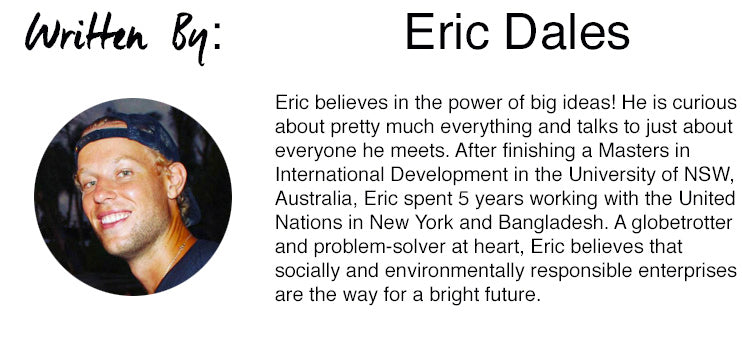{Note to readers: This photo is a screenshot from a section of our Kickstarter video that we filmed on a Balinese street in front of someone else's home, sweating profusely and cutting periodically due to rooster sounds. And yes, I have a terrible moustache. I bet my team that I would keep it until we reached our goal. I do not endorse this as a crowdfunding strategy, it's cruel to your loved ones and colleagues who have to look at your furry upper lip for an entire month.}

The First 24 hours
Whoa, you’re live. You clicked the button, celebrated for about 10 seconds, saw a few backers come on board, then started sweating profusely (or maybe that was just the fact that we were in Indonesia). If you’re 12 hours ahead of your home time zone, like us, you would have launched and then realized that you’re about to pull an all nighter. If you’re a normal person / business, launch in the morning and spend the next 24 hours getting in touch with as many people as you can.
You have to KILL IT in the first 100 hours (ok, 96 hours, but 100 sounds more motivational). You will have a lull in the middle when people don’t have the launch or the deadline to get all excited about. TAMGA got to 40% of our goal within 4 days*, but it took us 27 days to reach 100%. You don’t want to be playing catch-up in the middle of your campaign, a time when even the best guys/gals can’t get as many backers.
Get posts up on Facebook, Twitter, Instagram and whatever other social platforms you’re on (PS – twitter is the premier network for crowdfunding, it doesn’t matter if you think it’s copping a beat-down from Instagram, get on it). Our team messaged nearly every friend we have on Facebook individually, and kept a list of people to follow-up with. You’ll be surprised at how supportive old friends and acquaintances can be, so don’t be shy.
*Within our first 4 days, we also had our rented motorbike stolen, spent at least 12 hours in a Balinese police station (re: stolen motorbike), got a bacterial knee infection from surfing in dirty water, went through an earthquake and adopted two kittens which were dumped on our doorstep (we found a great home for them). It was intense.
Getting the ‘Project We Love’ badge
It’s great to get this little stamp of appreciation (we saw a lot of backers come from the ‘projects we love’ page), but we can’t tell you exactly how to do it. There’s no formula, just make a great campaign and hopefully the fine peeps at Kickstarter like it!
“We’ll get you more backers”
Get used to seeing this sentence. You will be force-fed it through online advertisements and Kickstarter messages throughout your campaign. Is it true? Not really. Depends. Maybe. But not in our case. We found that we got backers by creating engaging content, and doing the hard work to share our content organically. There’s no shortcut to getting people to part with their money, even if these apps give you access to “thousands of superbackers” (as if these people are just waiting to throw their money at you). Facebook and Google advertising can definitely get your campaign out there as well, but don’t go in without a solid understanding of how their targeting and audiences work (if you have a large email list or a lot of website traffic already, create an audience using this).
Anyways, I digress. I can suggest one paid service that we started using during Kickstarter and continue to use now – twitter marketing through Krowdster. Remember how I mentioned that Twitter is the premier social network for crowdfunding? I’m not kidding. Campaigns and ideas get shared through Twitter all day, every day, and you’re leaving a lot of interested people on the table if you don’t join in. Krowdster automates a lot of your engagement on Twitter by following accounts that talk about your keywords, liking relevant tweets and sending a customized welcome message to each new follower (psst: send them to your Kickstarter page).
Contacting Bloggers
We should definitely have this section in the first part of the series (pre-launch). But, like many others out there, we were immersed in creating our campaign and video and slacked a bit on getting bloggers and media onboard. By all means you should try and get some media partners on board before you launch to help boost your first 4 days, they have busy schedules and can’t always pump out an article before your campaign ends.
But if you slacked like us, don’t panic. Find bloggers and journalists who write about your subject area (Ethical Writers Coalition was super useful for us), and contact them personally. We didn’t manage to get any mainstream media to cover TAMGA, but we did find a lot of bloggers who really believed in our product and mission. You just need to accept that the vast majority of people you contact won’t respond – if it gets you down, have a little chat with Bill Murray and get back at it.
Finding Influencers with Influence
Don’t have a huge budget for influencers? Neither did we. In the fashion industry, there are tons of influencers who would love to charge a few hundred bucks for an Instagram post and move on. Do your homework, look at people in the range of 10,000 – 50,000 followers, and ask if they would be interested in featuring your product before your Kickstarter ends. TAMGA has a great network of influencers who have relevant audiences and are genuinely interested in our brand. We send over a product of their choosing, and the resulting posts are usually pretty great.

In the meantime - have a look at the sustainable fashion designs that got us to €26,000 on Kickstarter.






Leave a comment